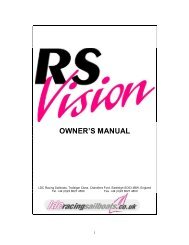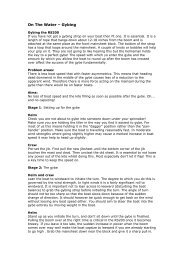rs200 owner's manual - Rs Sailing
rs200 owner's manual - Rs Sailing
rs200 owner's manual - Rs Sailing
Create successful ePaper yourself
Turn your PDF publications into a flip-book with our unique Google optimized e-Paper software.
(7) When you attach the spinnaker (see:- Rigging the spinnaker), this line<br />
must be fed through the spinnaker sock to the chute mouth and tied to the<br />
downhaul patch on the spinnaker. A sail batten or stiff wire will help with this<br />
on the first occasion.<br />
(8) Remember to pull the end of the spinnaker sheet or some other rope<br />
back through the sock when you subsequently de-rig in order to facilitate this<br />
action in future.<br />
Hoisting the Jib<br />
When using a brand new jib for the first time carefully unroll it in a clean area<br />
and hold it out by the three corners:-<br />
(1) Ensure that the eye in the luff wire at the head is correctly aligned with<br />
the attaching tape.<br />
(2) Now whilst applying firm tension to the luff wire make a small lashing at<br />
the tack between the eyelet in the sail and the eye in the luff wire ensuring<br />
these are correctly aligned. (You cannot do this with the jib rolled as this twists<br />
the wire relative to the sail.)<br />
(3) Leave the lashing quite slack at this stage you can adjust the tension<br />
once the sail is hoisted and the luff wire correctly tensioned.<br />
(4) Attach the jib sheets, knotting the sheet rope at its centre through the<br />
clew cringle.<br />
(5) At the boat, shackle the tack to the same eye bolt as the forestay<br />
ensuring the eye in the luff wire and the sail lashing are correctly aligned fore<br />
and aft without any twists.<br />
(6) Shackle the jib halyard to the head of the jib, ensuring the jib or halyard<br />
are not twisted.<br />
(7) Tape these two areas generously to prevent snagging the spinnaker.<br />
(8) Hoist the sail by pulling on the jib halyard tail, which exits from a slot<br />
just beneath the gooseneck<br />
(9) Hook the loop of wire which emerges onto the jib halyard tensioning<br />
purchase. It may help to obtain sufficient slack at this point if one crew<br />
member pulls firmly forward on the forestay.<br />
(10) Ensure that the tensioning purchase is not twisted or fouling other<br />
systems (it should be the one closest to the mast).<br />
(11) Pull on some rig tension, a generous heave should be sufficient.<br />
(12) Stow the halyard tail in the halyard bag provided.<br />
(13) Check that the forestay now has plenty of slack in it and that the jib is<br />
not twisting at the head. If it is, it may be necessary to lower the sail and turn<br />
the wire (undoing the temporary lashing) at the tack until the sail lies fairly well<br />
fore and aft.<br />
(14) Adjust the lashing at the tack so that the tension is just sufficient to<br />
remove the wrinkles in the sail cloth (it may be necessary to redo these<br />
adjustments after one or two sails as the jib and luff wire settle down).<br />
(15) Finally pass the jib sheets through the jib fairleads andfinish off with a<br />
figure of eight knot in the usual manner.<br />
(16) If conditions permit cleat the jib to save it flapping and remember never<br />
leave any sails especially the jib and spinnaker flapping unnecessarily as this<br />
considerably shortens the life of the sail.<br />
6




